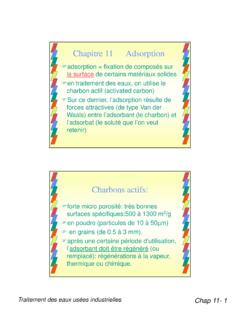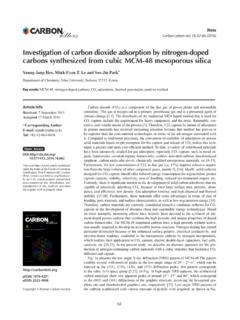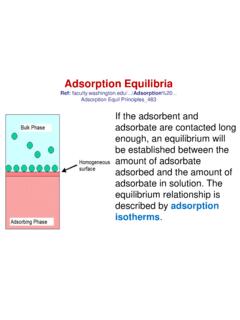Transcription of A New Classification of Adsorption Isotherms - …
1 JHUA New Classification of Adsorption IsothermsWhen a gas comes into contact with a solid surface, molecules of the gas will adsorb (stick)to the surface in quantities that are a function of their partial pressure in the bulk. The measure-ment of the amount of gas adsorbed over a range of partial pressures at a single temperatureresults in a graph known as an Adsorption isotherm. Many different types of Isotherms havebeen observed in the literature1,2; these Isotherms can have very different shapes depending onthe type of adsorbent, the type of adsorbate, and intermolecular interactions between the gasand the first systematic attempt to interpret Adsorption Isotherms for gas-solid equilibria wasintroduced by Brunauer, Deming, Deming, and Teller3(BDDT) in 1940.
2 These authors clas-sified Isotherms into five types. The BDDT classification has become the core of the modernIUPAC classification of Adsorption isotherms4,5; these BDDT Isotherms and an additional oneintroduced much later by Sing, which completes the IUPAC classification, are illustrated inFigure 1. Type I Isotherms characterize microporous adsorbents. Types II and III describeadsorption on macroporous adsorbents with strong and weak adsorbate-adsorbent interactions,respectively. Types IV and V represent Adsorption Isotherms with hysteresis. Finally, type VIhas steps. The BDDT and IUPAC classifications have two deficiencies: they are incompleteand they give the incorrect impression that Adsorption Isotherms are always monotonic func-tions of pressure.
3 This is because the IUPAC classification only takes into account adsorptionat subcritical this project, we analyzed available experimental data and predictions from lattice densityfunctional theory (DFT), a theoretical tool which has been developed by our research this study, we have proposed a new classification of Adsorption Isotherms . This newclassification scheme is shown in Figure general, this new classification is meant to be qualitative and does not show all possi-ble details. In this classification, Type I shows Adsorption Isotherms on microporous adsorbentsfor subcritical, near critical, and supercritical conditions. Notice that the isotherm is not mono- Figure 1: The IUPAC classification for Adsorption Marc DonohueDepartment of Chemical EngineeringJohns Hopkins UniversityJHUtonic at supercritical conditions.
4 Types II and III give Adsorption Isotherms on macroporousadsorbents with strong and weak affinities, respectively. For low temperatures these Types havesteps, but increasing temperature transforms them into the smooth monotonic curves which arelike those in Types II and III of the IUPAC classification. However, near the critical temper-ature these Isotherms change dramatically to non-monotonic behavior showing sharp maxima,and further increase in temperature leads to Isotherms with smooth maxima. Types IV and Vcharacterize mesoporous adsorbents with strong and weak affinities, respectively. For lowertemperatures they show Adsorption hysteresis. Figure 2: A new classification for Adsorption , G. of Adsorption ; Engineering Foundation: New York, 1984, pp.
5 , J. T.; McKeehan, T. W.; Danner, R. Chem. Eng. Data1981, 26, , S.; Deming, L.; Deming, W.; Teller, Am. Chem. , 62, RecommendationsPure Appl. , 57, RecommendationsPure Appl. , 66, Marc DonohueDepartment of Chemical EngineeringJohns Hopkins University






